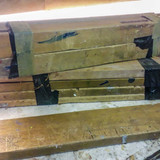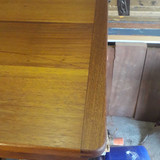Peri
Established Member
Hi,
Basic question - how can you hide or tidy up the end grain of a table top?
I have an old science desk top that I'm using for a new desk. I've cleaned it up, but the end-grain looks a bit shabby where they've joined the boards with some kind of floating tenon.
I'd like to add a 1/2" roundover to all the top edges, so ideally a frame around the top would be the way to go - but I don't think that's a good idea (no allowance for wood movement).
Whats the best way? Just fill the holes and leave the endgrain on show?
Thank you,
Steve.
Basic question - how can you hide or tidy up the end grain of a table top?
I have an old science desk top that I'm using for a new desk. I've cleaned it up, but the end-grain looks a bit shabby where they've joined the boards with some kind of floating tenon.
I'd like to add a 1/2" roundover to all the top edges, so ideally a frame around the top would be the way to go - but I don't think that's a good idea (no allowance for wood movement).
Whats the best way? Just fill the holes and leave the endgrain on show?
Thank you,
Steve.

















































